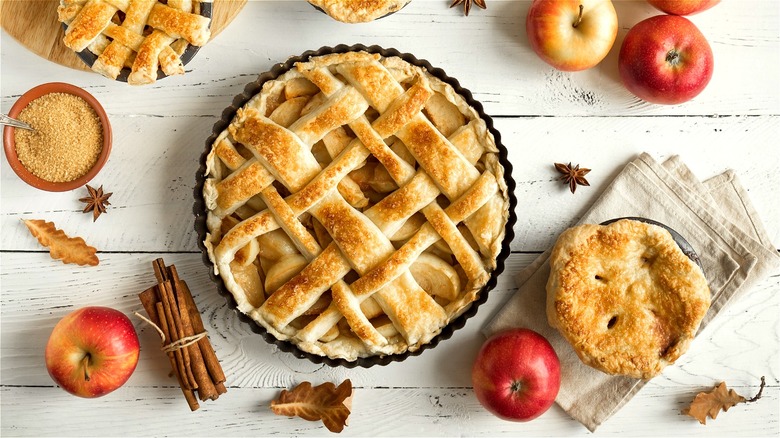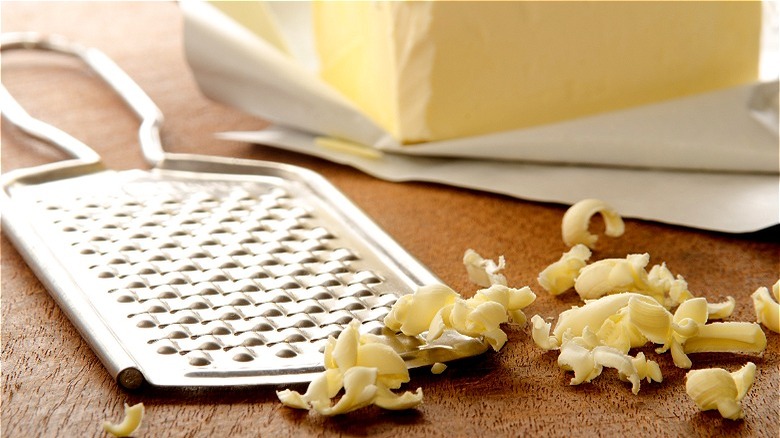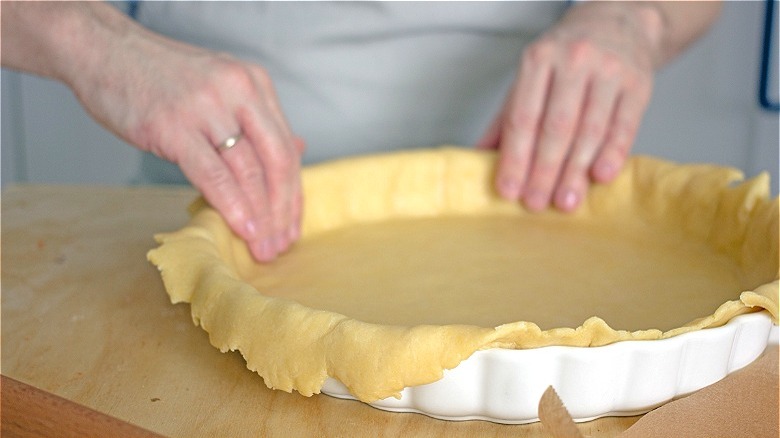The Cheese Grater Hack That Will Make Your Pie Crust Even Flakier
Most dessert lovers agree there's nothing quite like a warm slice of pie. The American Pie Council notes 90% of Americans believe pie serves as one of life's simplest delights. When you consider the pie crust's twisted history, however, you start to realize the evolution of time has witnessed some drastic developments.
What's Cooking America notes pastry dough, in all its flaky abundance, used to be everything but edible: The Greeks and Romans used pie crust as a way to encase precious savory filling to withstand long hours of cooking. While the exact time in history when pie crust became consumable and dare say enjoyable is a little muddy, Janet Clarkson, author of "Pie: A Global History," believes the notion of eating the encasement started with the lower class out of necessity (per The Madisonian). To think we've gone from a crust once used to encase birds and seafood in 17th-century England as a matter of enjoyment, to the delectable antidote for those sweet and savory fillings in modern America is quite astounding.
The Madisonian also claims the most significant developments in pie history happened with the introduction of moldable fats like lard and butter in the UK. Nowadays, most home cooks find their favorite apple pie always calls for a crust with significant amounts of fat, and let's be honest: Everyone wants a flakier crust. Surprisingly, a cheese grater may bring you one step closer.
How the cheese grater helps evenly distribute your pie crust's ingredients
Whichever standard pie crust recipe you're following, there's a solid chance the instructions call for a streamlined list of ingredients. The Oregonian claims flour, sugar, salt, ice water, shortening, and butter (or one over the other) are the essential constituents in Adrienne Kane's "United States of Pie" and mirror most available pie crust recipes today.
Before getting into why the cheese grater can be a game changer, it's important to know why butter needs to be kept cold before and during its incorporation into your pie dough. King Arthur Flour Baking Company insists cold butter is essential in creating those desired layers of flakiness. A dough's shape will keep when cold butter is used and cut into chunks. The flakiness occurs when those chunks of butter melt and a small amount of evaporation occurs.
If you do the mental math, smaller pieces of butter mean more delicate layers, hence the brilliant use of a cheese grater. According to Williams Sonoma, to start, partially freeze your butter, then grate and freeze again before incorporating it into your dough. Then simply add in the cold butter with a fork before shaping the mix into discs. This method ensures even pockets of butter and flakier layers. Next to the cheese grater, there are additional tips you can follow in your quest to achieve the perfect pie dough.
How to create the flakiest pie crust
While some may claim clear liquor is the trick to perfectly flaky pie crust, others believe the key to tender pastry is all in the fat. King Arthur Baking Company proposes butter and sour cream make the flakiest crust of all, but if you're more into following a standard recipe, Land O'Lakes outlines the most commonly used ways to add in this most coveted component.
While the use of a fork is mentioned above, Land O' Lakes also suggests using a pastry cutter, two butter knives, and even a food processor. Surprisingly, the number one tool you shouldn't use when cutting in butter is your own hands. The heat emanating from your fingertips can warm the butter, which can lead to overmixing.
Beyond the precious handling of fat, as you perfect your pie-making skills, MasterClass suggests keeping some essential reminders at the forefront of your mind. For starters, be sure not to overmix, and always make sure to properly chill your dough. MasterClass also suggests rolling out your pie dough with enough flour, and "blind baking" so your precious dough can stand firm against any overly wet fillings. Whether or not you choose to use a cheese grater for your next pie crust, keeping these essential tips in mind will inch you closer and closer to a flakier crust.


